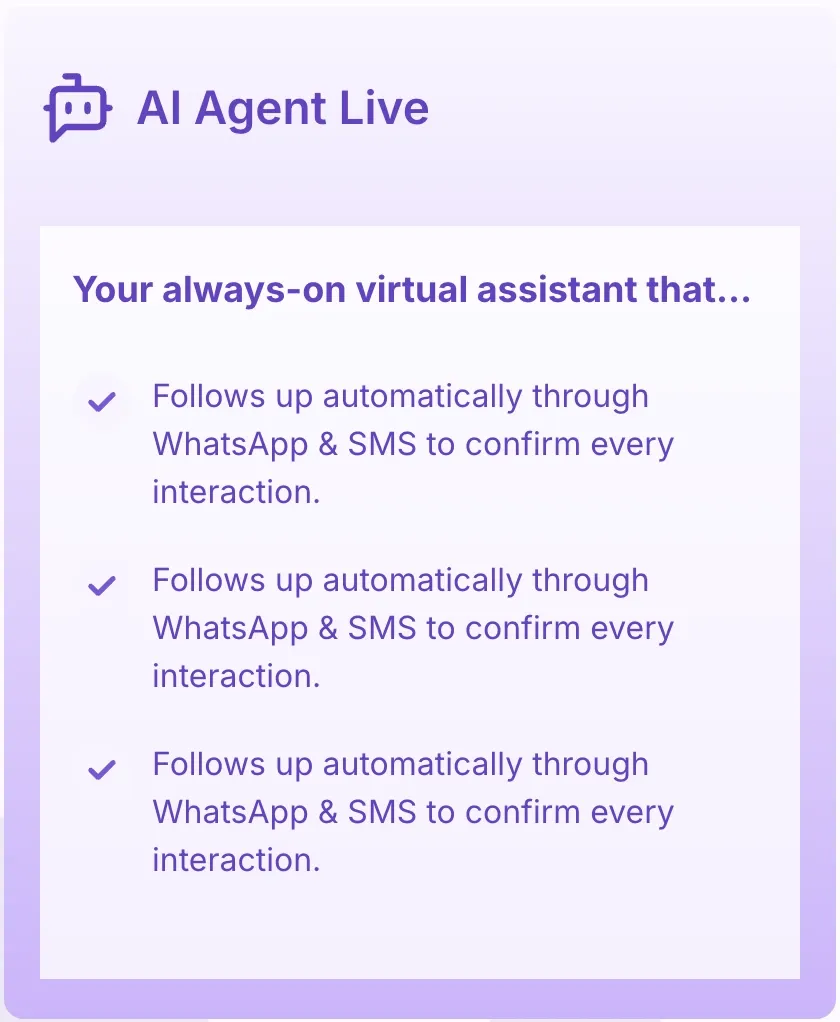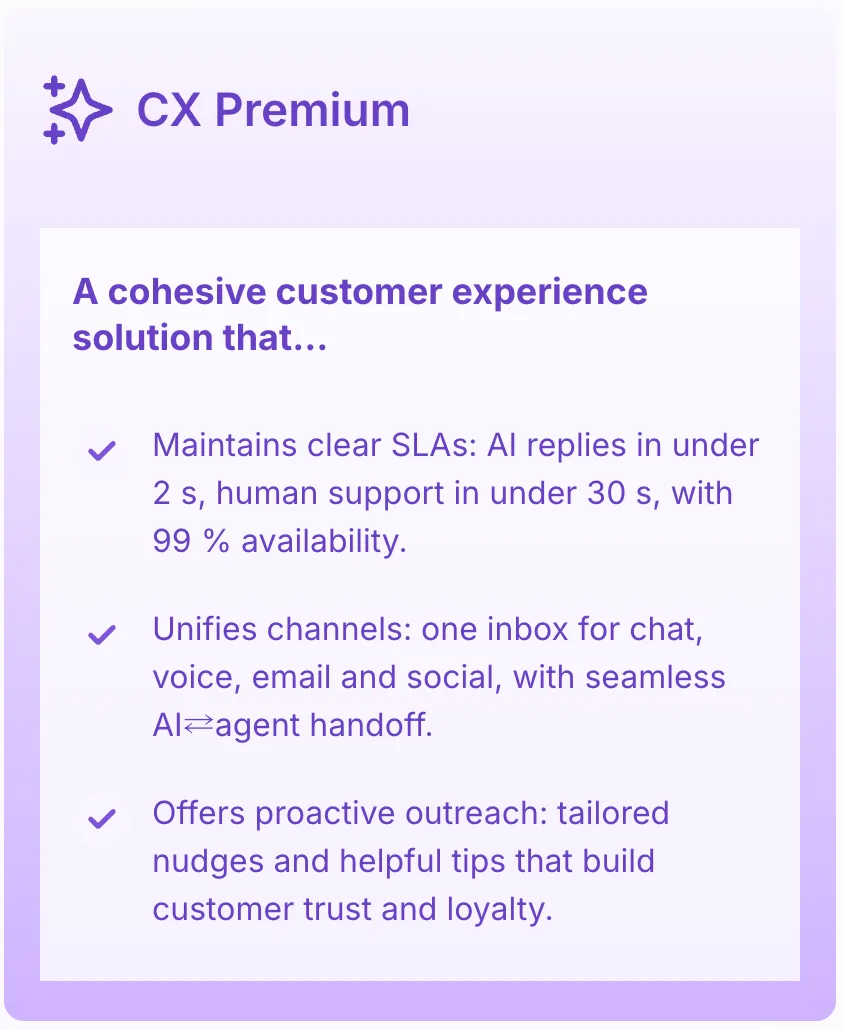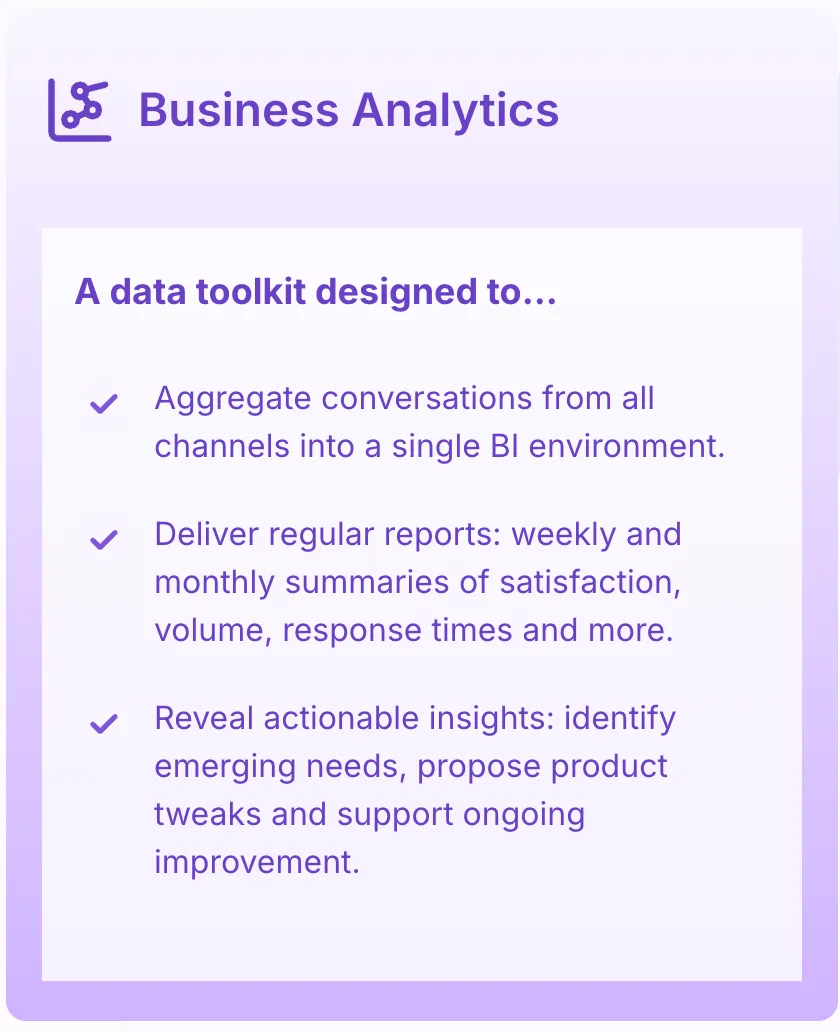The customer journey consists of several stages:
- Awareness: The first time a customer comes across your brand
- Consideration: When a customer researches and evaluates your product
- Purchase: The moment a customer completes a transaction
- Support: Assistance provided after a purchase
- Loyalty: Building an ongoing relationship with the customer
Each stage presents unique opportunities for your customer service team to demonstrate value and build lasting relationships. A recent Salesforce survey revealed a striking statistic: effective customer service increases repurchase likelihood by 91%. This data underscores the direct link between service quality and business growth.
Your service team's responsibilities go beyond simply solving problems. They also serve as:
- Brand ambassadors
- Problem solvers
- Relationship builders
- Information providers
- Sales strategists
In the digital age, customer service has evolved to meet changing expectations. Your team must deliver comprehensive support while creating lasting impressions that drive customer satisfaction and loyalty. This ability to adapt and respond to customer needs is what determines whether your service team truly fulfills their essential responsibilities.

1. Role of Customer Service Representatives in Ensuring a Positive Customer Experience
Customer service representatives (CSRs) are the crucial link between your business and customers at every stage of their journey. They are the first point of contact for product inquiries, assist customers during purchases, and offer vital support after the sale.
Key Responsibilities of CSRs:
- Managing customer calls and inquiries
- Generating qualified leads
- Assessing customer needs
- Processing orders and handling payments
- Providing product demonstrations
- Maintaining accurate customer records
Problem-solving is a critical skill for CSRs. Your representatives need to:
- Diagnose issues quickly and accurately
- Develop creative solutions for unique challenges
- Escalate complex problems to the appropriate teams
- Follow up to ensure complete resolution
- Update knowledge bases with new solutions
Effective communication is the foundation of strong customer relationships. Your CSRs build trust through:
- Clear, concise explanations of products and services
- Active listening to understand customer needs
- Empathetic responses to customer concerns
- Professional tone across all interactions
- Personalized service delivery
The impact of skilled CSRs is directly reflected in business metrics. Companies with strong customer service teams see:
- Higher customer satisfaction rates
- Increased repeat purchases
- Improved brand loyalty
- Enhanced cross-selling opportunities
- Positive word-of-mouth referrals
Your CSRs also play a crucial role in identifying sales opportunities through customer interactions. They recommend relevant products based on customer needs, turning support conversations into revenue-generating opportunities while maintaining a helpful, non-pushy approach.
2. Leveraging Technology to Enhance Customer Service Operations
AI-powered chatbots are changing the game for customer service operations by efficiently handling routine inquiries. These digital assistants can manage multiple customer requests at the same time, providing instant answers to common questions about product features, pricing, and basic troubleshooting.
How Chatbots Work
The use of Natural Language Processing (NLP) technology enables chatbots to accurately understand customer queries. NLP algorithms analyze customer messages, identify the intent behind them, and generate relevant responses - creating smooth interactions that resemble human conversations.
Key Benefits of AI-Powered Customer Support:
- 24/7 Availability: Chatbots are available all day, every day, eliminating wait times and providing immediate support across different time zones.
- Consistent Service Quality: AI systems deliver uniform responses, maintaining service standards in every interaction.
- Scalable Operations: Handle large volumes of inquiries during busy periods without needing extra staff.
- Cost-Effective Solutions: Lower operational costs while still delivering high-quality service.
Enhancing Customer Interactions with NLP Technology
NLP technology improves customer interactions in several ways:
- Analyzing customer emotions through sentiment analysis
- Supporting multiple languages for global customers
- Retaining context for personalized conversations
- Recognizing patterns to enhance response accuracy
Streamlining Support Processes with AI Systems
Modern AI systems automatically capture and categorize customer inquiries, creating detailed logs of interactions. This data helps identify common issues, track resolution times, and optimize support processes. The technology also identifies complex cases that require human intervention and smoothly transfers conversations to live agents with complete interaction history.
Real-World Application of AI-Powered Customer Support
Platforms like Yellow.ai showcase the practical use of these technologies in customer support. They handle interactions across 35+ channels while maintaining natural conversations in 135+ languages. These systems analyze customer data in real-time, providing agents with actionable insights and suggestions for better service delivery.
3. The Power of Active Listening and Empathy in Delivering Exceptional Service
Active listening and empathy create the foundation for meaningful customer interactions. You can transform routine support conversations into opportunities for building lasting relationships by mastering these essential skills.
Essential Active Listening Techniques:
- Pause before responding to fully absorb customer concerns
- Use verbal acknowledgments like "I understand" or "I hear you"
- Reflect the customer's exact words when clarifying issues
- Take notes during conversations to capture key details
- Summarize main points to confirm understanding
Building Genuine Empathy:
- Recognize emotional cues in customer's tone and language
- Validate feelings with phrases like "I can see why this is frustrating"
- Share relevant personal experiences when appropriate
- Adjust communication style to match customer's emotional state
- Focus on solutions while acknowledging the impact of the problem
Your response during challenging situations shapes the customer's perception of your brand. When a customer expresses frustration about a delayed shipment, you might say: "I understand how this delay affects your business operations. Let's look at the available options to minimize the impact."
Practical Empathy Exercises:
- Review past customer interactions from the client's perspective
- Practice role-playing difficult scenarios with team members
- Study customer feedback to identify emotional patterns
- Document successful resolutions as learning examples
- Create response templates that incorporate empathetic language
AI tools can enhance these human elements by detecting emotional signals and suggesting appropriate responses. This combination of technology and genuine human connection creates a powerful foundation for exceptional customer service.

4. Embracing Omnichannel Communication to Meet Evolving Customer Expectations
An omnichannel approach creates a unified customer experience across multiple communication channels. This strategy allows customers to interact with your business through their preferred platforms while maintaining consistent service quality.
Key Benefits of Omnichannel Support:
- Seamless Experience: Customers can start a conversation on one channel and continue it on another without repeating information
- Increased Accessibility: Support available through phone, email, chat, social media, and messaging apps
- Better Data Collection: Comprehensive view of customer interactions across all touchpoints
- Improved Response Times: Real-time support through automated and human assistance
- Enhanced Customer Satisfaction: Personalized interactions based on customer preferences
Implementing an Effective Follow-Up Process
A robust follow-up system strengthens customer relationships and prevents issues from recurring. Yellow.ai's automation capabilities enable businesses to schedule follow-up messages across 35+ channels, ensuring consistent communication.
Essential Elements of Follow-Up Communication:
- Timing: Send follow-ups within 24-48 hours of issue resolution
- Personalization: Reference specific details from previous interactions
- Channel Selection: Use the customer's preferred communication method
- Clear Purpose: State the reason for follow-up and expected outcomes
- Action Items: Include next steps or additional resources if needed
Follow-ups demonstrate your commitment to customer satisfaction and provide valuable insights for service improvement. Companies using systematic follow-up processes report higher customer retention rates and increased positive feedback.
Measuring Follow-Up Success:
- Track response rates to follow-up communications
- Monitor customer satisfaction scores post-follow-up
- Analyze feedback patterns to identify areas for improvement
- Record resolution confirmation rates
- Measure customer retention metrics
Businesses implementing comprehensive omnichannel strategies with systematic follow-ups experience up to 91% higher year-over-year customer retention rates compared to those using single-channel approaches.
5. Maintaining Professionalism While Navigating Challenging Situations with Customers
Handling challenging customer interactions requires a balanced approach of emotional control and professional conduct. Here's how you can maintain composure during difficult conversations:
Practice Emotional Regulation
- Take deep breaths before responding
- Count to ten silently when feeling overwhelmed
- Step away briefly if needed (with proper communication)
- Use positive self-talk to maintain perspective
Implement De-escalation Techniques
- Speak in a calm, measured tone
- Lower your voice volume gradually
- Use neutral language
- Focus on solutions rather than problems
Reframe Negative Situations
- View complaints as improvement opportunities
- Consider cultural or personal factors affecting behavior
- Think of challenging interactions as skill-building exercises
- Remember that anger is rarely personal
Structure Your Response
- Acknowledge the customer's frustration
- Repeat their concerns to show understanding
- Present clear, actionable solutions
- Set realistic expectations about outcomes
Maintain Physical Composure
- Keep facial expressions neutral
- Maintain open body language
- Stay seated or standing straight
- Keep hand movements minimal and controlled
Your ability to stay professional under pressure directly impacts customer satisfaction and resolution outcomes. Companies like Yellow.ai enhance this capability by providing AI-powered support that helps identify emotional cues and suggests appropriate responses, enabling you to navigate difficult conversations more effectively.

Future Trends: The Role of AI in Shaping the Next Generation of Customer Service Support
AI technology is changing the game for customer service support, offering businesses new ways to provide outstanding experiences on a large scale. With advanced AI solutions like Yellow.ai, traditional support models are being transformed into smart, automated systems.
Key AI Innovations in Customer Service:
- Multilingual Support: AI-powered platforms now handle customer interactions in 135+ languages, breaking down communication barriers
- Sentiment Analysis: Advanced algorithms detect emotional cues in customer messages, enabling appropriate responses
- Predictive Analytics: AI systems anticipate customer needs by analyzing interaction patterns
- Real-time Insights: AI provides agents with contextual suggestions during customer interactions
Success Stories:
"Hyundai achieved approximately 1,000 car sales and a 10% retail conversion rate through AI-powered customer service implementation"
"Pelago reported a 50% deflection rate within just six weeks of implementing AI solutions"
AI-Enhanced Customer Service Features:
- Automated routine inquiry handling
- 24/7 support availability
- Intelligent escalation to human agents
- Personalized product recommendations
- Cross-channel communication management
- Real-time performance analytics
The future of customer service lies in the seamless integration of AI capabilities with human expertise. AI platforms streamline operations, enhance efficiency, and enable personalized interactions at scale. As technology continues to evolve, businesses that embrace these innovations will gain a significant competitive advantage in delivering superior customer experiences.
Emerging Trends:
- Voice-enabled AI assistants
- Augmented reality support
- Predictive customer service
- Hyper-personalization through machine learning
- Blockchain integration for secure transactions
Future Trends: The Role of AI in Shaping the Next Generation of Customer Service Support
AI technology is changing customer service operations at an incredible speed. Yellow.ai is leading this change, helping businesses provide scalable support through advanced automation and natural language processing.
Key AI advancements reshaping customer service include:
- Multilingual Support: AI-powered systems now communicate effectively in 135+ languages, breaking down language barriers
- Sentiment Analysis: Real-time emotion detection allows for personalized responses aligned with customer mood
- Predictive Analytics: AI systems anticipate customer needs by analyzing interaction patterns
- Automated Task Management: Routine inquiries receive instant responses, freeing human agents for complex issues
Real-world success stories demonstrate AI's impact:
"Hyundai achieved approximately 1,000 car sales and a 10% retail conversion rate through AI-powered customer service implementation"
The integration of AI in customer service responsibilities produces measurable results:
- 50% reduction in support tickets
- 24/7 consistent service delivery
- Enhanced personalization at scale
- Improved first-response times
AI systems like Yellow.ai now handle complex tasks:
- Issue identification and categorization
- Real-time agent assistance
- Automated follow-ups
- Cross-channel communication management
- Performance analytics and reporting
These technological advancements create a hybrid service model where AI handles routine tasks while human agents focus on relationship-building and complex problem-solving.
FAQs (Frequently Asked Questions)
What are the primary responsibilities of customer service representatives in enhancing the customer journey ?
Customer service representatives serve as the main point of contact throughout the customer journey, utilizing problem-solving skills to address issues promptly and employing effective communication to build rapport and understand customer needs, thereby ensuring a positive customer experience.
How can AI-powered chatbots and natural language processing improve customer service operations ?
AI-powered chatbots handle routine inquiries efficiently, providing 24/7 support, while natural language processing (NLP) enhances the accuracy and speed of customer interactions, leading to improved service quality and operational efficiency.
Why are active listening and empathy crucial in delivering exceptional customer service ?
Active listening techniques, such as paraphrasing and summarizing customer concerns, help ensure understanding, while empathy building exercises enable representatives to acknowledge customers' emotions by putting themselves in their shoes, fostering trust and satisfaction.
What is an omnichannel approach in customer support, and why is follow-up important ?
An omnichannel approach integrates multiple communication channels to provide seamless support experiences for customers. Implementing an effective follow-up process across these channels is vital for resolving issues thoroughly and enhancing long-term customer satisfaction and loyalty.
How can customer service professionals maintain professionalism during challenging interactions with customers ?
Maintaining professionalism involves staying calm and composed when dealing with irate or demanding customers by practicing techniques such as deep breathing and reframing negative thoughts, which helps manage difficult situations effectively while upholding service standards.
What role does collecting customer feedback play in continuous improvement of customer service ?
Gathering customer feedback through methods like surveys or post-interaction follow-ups provides valuable insights that businesses can use to identify areas for improvement, drive service excellence, and adapt to evolving customer expectations.












